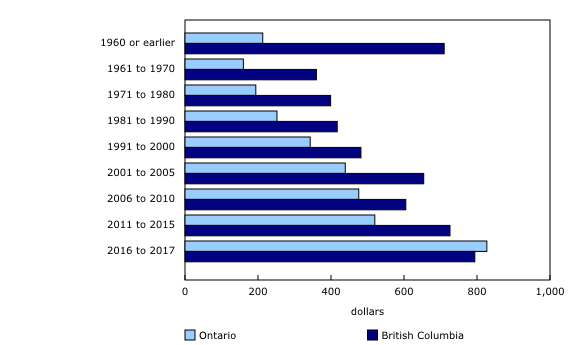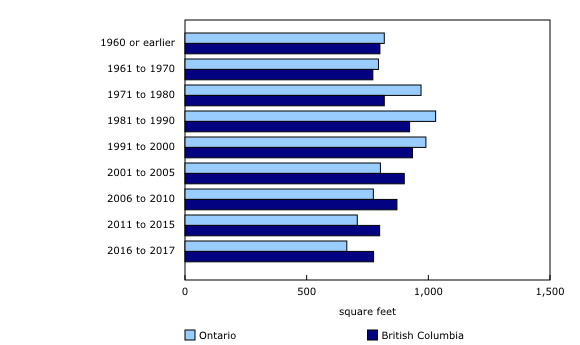Canadian Housing Statistics Program
Archived Content
Information identified as archived is provided for reference, research or recordkeeping purposes. It is not subject to the Government of Canada Web Standards and has not been altered or updated since it was archived. Please "contact us" to request a format other than those available.
Released: 2019-05-03
New data on assessment value per square foot and above-grade living area
Today, the Canadian Housing Statistics Program is providing information on the total and above-grade living areas of residential properties in Nova Scotia, Ontario and British Columbia. The above-grade living area excludes finished basements and levels below ground and serves as a standardized measure to compare property sizes across geographies. Statistics Canada is also releasing a new indicator―assessment value per square foot—to allow for more detailed comparisons of assessment values among property types and across geographies.
The assessment value per square foot is obtained by dividing the assessment value of a residential property by its total living area, which includes finished basements. This indicator allows for comparisons among different property types in different regions and may be used to show trends in the property value on a per-unit basis.
A detailed analysis using these data is provided in the Canada Mortgage and Housing Corporation article, "Overview of Residential Property Living Areas in British Columbia, Nova Scotia and Ontario," which is available today.
Assessment values per square foot are higher in British Columbia than in Ontario and Nova Scotia
The median assessment value per square foot is higher for all property types in British Columbia than in Ontario and Nova Scotia. The median value per square foot of a single-detached house in British Columbia is $317, which is 55% higher than in Ontario ($205) and almost three times the value in Nova Scotia ($113).
For condominium apartments, the median value per square foot is $547 in British Columbia, compared with $375 in Ontario.
Differences in property values per square foot are also apparent among the largest census metropolitan areas (CMAs) in Nova Scotia, Ontario and British Columbia.
The Vancouver CMA is home to properties with the highest median values per square foot for all residential property types. Most notably, the median assessment value per square foot of a semi-detached house in the Vancouver CMA ($675) is twice as high as in the Toronto CMA ($337) and more than five times the value in the Halifax CMA ($126). However, semi-detached houses represent a small proportion of the property stock in the Vancouver CMA (2%), compared with Toronto (12%) and Halifax (8%).
The census subdivisions (CSDs) with the highest median assessment values per square foot for single-detached houses and condominium apartments are located in the Vancouver CMA, such as Metro Vancouver A, West Vancouver and the City of Vancouver. Residential properties in Whistler, British Columbia, also have relatively high assessment values per square foot.
The City of Toronto ranks 29th among CSDs in terms of the median value of single-detached houses at $404 per square foot, less than half the price in the City of Vancouver ($960). Moreover, condominium apartments in the City of Toronto are valued at $502 per square foot, just over half the price compared with the City of Vancouver ($941).
Across the CMAs, the lowest values per square foot for single-detached houses are in Windsor ($116), Belleville ($130) and Thunder Bay ($144). For condominium apartments, the lowest values per square foot are also in Windsor ($122), followed by London ($128) and Belleville ($138).
Newly built condominium apartments have higher values per square foot than older ones
Median assessment values per square foot for condominium apartments built after 1970 in Ontario are becoming progressively higher.
Condominium apartments constructed in 2016 and 2017 in Ontario have a median assessment value of $827 per square foot, which is 59% higher than for condominium apartments built in the province from 2011 to 2015. Differences are even more pronounced between the values of newly constructed condominium apartments and those built during the 1980s and 1990s. In the Toronto CMA, the median assessment value per square foot for condominium apartments built in 2016 and 2017 is $916, the highest among CMAs over this period.
In British Columbia, the vast majority of condominium apartments built in 1960 or earlier are in the CMAs of Vancouver and Victoria. While their median value is relatively high, at $710 per square foot, they account for less than 1% of the total condominium stock in the province.
For condominium apartments built in 2016 and 2017 in British Columbia, the median assessment value per square foot ($794) is lower than in Ontario for the same period of construction. Recently built condominium apartments in British Columbia are 9.4% higher valued per square foot compared with those constructed from 2011 to 2015. While this is less marked than in Ontario, marked differences are still observed between the values of newly constructed condominium apartments and those built in the 1980s and 1990s. In the Vancouver CMA, condominium apartments built in 2016 and 2017 are valued lower than those in the Toronto CMA ($829 per square foot versus $916).
Generally speaking, higher assessment values and smaller living areas combine to increase the assessment value per square foot of newer condominium apartments in Ontario and British Columbia.
Single-detached houses are generally larger in Ontario
In Ontario, the median above-grade living area of a single-detached house is 1,520 square feet, compared with 1,430 in British Columbia and 1,150 in Nova Scotia.
Across the three provinces, row houses are similarly sized. The median above-grade area in Nova Scotia is 1,410 square feet, slightly higher than in Ontario (1,350) and British Columbia (1,330). The vast majority (93%) of Nova Scotia's row houses are in the Halifax CMA.
Condominium apartments have nearly the same square footage in British Columbia (876) and Ontario (862). Within the CMAs, condominium apartments in Toronto (840 square feet) and Vancouver (854 square feet) are among the smallest. Over 70% of the stock of condominium apartments in British Columbia and Ontario are located in these two CMAs.
The largest condominium apartments in Ontario are in the CMAs of Barrie, Greater Sudbury and Hamilton, with a median living area of approximately 1,000 square feet. The CMAs of Barrie and Greater Sudbury collectively account for less than 1% of the condominium stock in Ontario, while the Hamilton CMA accounts for 3.2%.
Recently built single-detached houses are larger than those constructed earlier
In Nova Scotia, Ontario and British Columbia, recently constructed single-detached houses have a larger above-grade living area than those built earlier.
In Ontario, the median above-grade living area of recently built single-detached houses is 2,380 square feet. While the number of properties within this category account for a small proportion (1.3%) of the overall stock, they have an above-grade living area 30% larger than that of single-detached houses constructed during the 1980s and 1990s. Furthermore, single-detached houses built most recently are almost twice as large as houses built in 1960 or earlier.
New condominium apartments are smaller than older units
Contrary to what is observed among single-detached houses, recently built condominium apartments are smaller than older units.
In Ontario, the median living area of a condominium apartment built in 2016 and 2017 is 665 square feet, a decline of more than 30% in square footage compared with condominium apartments constructed in the 1980s and 1990s.
In British Columbia, condominium apartments built in 2016 and 2017 are more than 15% smaller—in terms of living area—than condominium apartments constructed during the 1980s and 1990s.
Overall, there is a positive correlation between the age of a condominium apartment and its size, with condominium apartments built after 1990 tending to have an increasingly smaller living area.
Note to readers
The analysis based on living area is restricted to the following residential property types: single-detached houses, semi-detached houses, row houses and condominium apartments.
Data on the living area of condominium apartments in Nova Scotia are not currently available.
Definitions
Residential property refers to all land and structures intended for private occupancy, whether on a permanent or temporary basis.
Assessment value refers to the assessed value of the property for the purpose of determining property taxes. It is important to note that the assessed value does not necessarily represent the market value. The assessment values in Nova Scotia and British Columbia are in 2017 dollars, while the assessment values in Ontario are in 2016 dollars. Given that different provinces and territories have their own assessment periods and durations of the valuation roll, it is difficult to make accurate comparisons of similar properties from one province or territory to another. For properties that are being utilized for both residential and non-residential purposes, only the residential portion's value has been taken into account.
Total living area refers to the residential living space within a structure. For residential structures that have a basement, the finished basement area is included in the total living area, while unfinished basement area is not included.
Above-grade living area refers to the living area of a residential property excluding basements and levels below grade.
Period of construction refers to the period in time during which the building or dwelling was originally constructed. This refers to the period in which the building was completed, not the time of any later remodeling, additions or conversions.
Contact information
For more information, or to enquire about the concepts, methods or data quality of this release, contact us (toll-free 1-800-263-1136; 514-283-8300; STATCAN.infostats-infostats.STATCAN@canada.ca) or Media Relations (613-951-4636; STATCAN.mediahotline-ligneinfomedias.STATCAN@canada.ca).
- Date modified:







